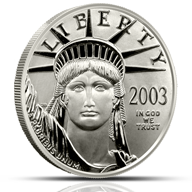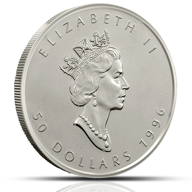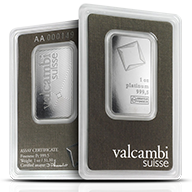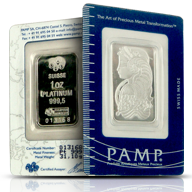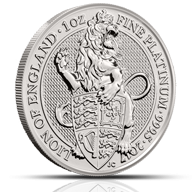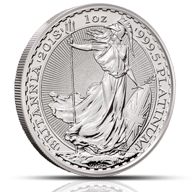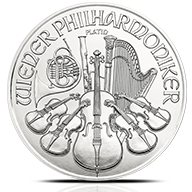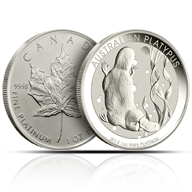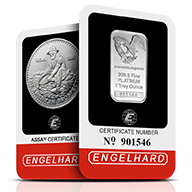Platinum Bullion at Provident Metals
One of the first alternatives to gold and silver that many investors turn to is platinum. This precious metal is one of the rarest elements on Earth and is widely used in a variety of industrial applications outside the precious metals field. Its value has fluctuated greatly over the course of time, with recent decades seeing platinum bullion production plummet in the late 20th and early 21st centuries before rising again (along with prices) in the 2010s.
Common Platinum Bullion
The two most common forms of platinum bullion in the market today are platinum coins and platinum bars. The two are produced by different types of mints, with the vast majority of platinum coins available from sovereign mints, while platinum bars are predominantly produced by private mints. Both offer .9995 purity in the metal, but come with a wide variety of designs and options for investors and collectors of all ranges. Common examples of platinum bullion include the following:
- 1 oz platinum bullion coins
- Fractional-ounce platinum bullion coins
- Minted platinum ingots
- Cast platinum bars
History of Platinum
Platinum was first encountered by European explorers in the 16th century when Spanish conquistadors in South America came across it in the alluvial deposits of the Chocó region in what is now Colombia. They considered it an unwanted impurity in their gold mining efforts and referred to it as “platina,” meaning “little silver” in Spanish.
The first recorded European reference to platinum was in 1557 by Italian scientist Julius Scaliger, who described the metal’s unique properties. Platinum’s resistance to corrosion and its density caught the attention of European scientists and jewelers in the 18th century. It began to be used in jewelry, particularly in Spain, and was considered a precious metal.
Evolution of Platinum in the Precious Metals Industry
During the 18th and 19th centuries, platinum became a popular choice for jewelry, especially in the courts of Spain, Russia, and France. Its malleability allowed for intricate designs, and its resistance to tarnish made it highly desirable. In the 19th century, platinum found various industrial applications, primarily due to its remarkable resistance to high temperatures and chemical reactions. It was used in laboratory equipment, electrical contacts, and crucibles for high-temperature processes.
Platinum continues to be highly sought after in the production of jewelry, especially for engagement rings and other high-end items. It has critical industrial applications in catalytic converters, where it helps reduce harmful emissions from vehicles. Platinum is also used in the chemical and petrochemical industries, as well as in the electronics sector.
More recently, platinum has gained popularity as an investment and hedge against inflation. It is traded on commodities markets, and there are platinum exchange-traded funds (ETFs) for investors.
Buy Platinum Bullion from Provident Metals
If you have any questions about platinum bullion, the Provident Metals team is happy to help. Please call us at 800-276-6508, connect with us online using our web chat, or simply send us an email with your inquiries.

